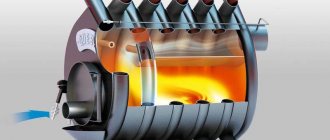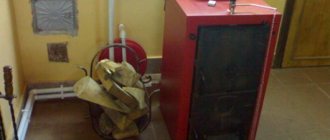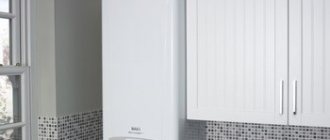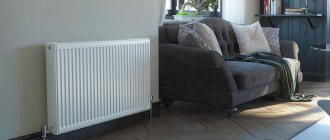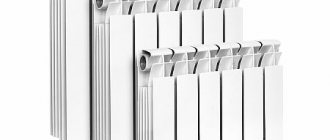Vertical radiators for liquid heating systems are conventional heating devices. The main difference between such models and traditional ones is their non-standard dimensions: the width of the radiator is much smaller than the height. Conventional batteries are installed, as a rule, under window openings, while vertical ones can be placed on walls in any room, including in niches, openings or in rooms where there are no windows at all. Vertical batteries are no different from horizontal ones in the main parameters:
- material – cast iron, steel, aluminum, bimetal;
- design – sectional, panel, tubular;
- connection method to the heating system pipelines - diagonal, side, bottom.
The main difference between vertical models is their original design, which combines a wide variety of shapes and color shades. This allows them to fit organically into the most sophisticated interiors.
Characteristics of a vertical radiator
Vertical equipment is produced from 1 to 3 meters in height and has many similarities with its horizontal counterpart. The batteries are distinguished by their impressive weight and size.
Therefore, in their manufacture, as a rule, cast iron is not involved, otherwise there will be a very strong load on the walls of the room. And you shouldn't expect a unique radiator design.
Material selection
The main feature that allows us to classify vertical radiators is the source material from which each of the products in question is made. In accordance with this criterion they are:
- made of cast iron or steel;
- aluminum;
- bimetallic;
- based on copper and plastic (extremely rare).
Cast iron batteries
Cast iron vertical heating radiator
Heating radiators made of cast iron are classic models that were widespread in past centuries. They are still in demand among consumers, which is explained by their following advantages:
- product strength;
- relatively low price;
- durability.
On the other hand, this material has a number of significant disadvantages, which forced manufacturers to master the production of modern samples based on more “advanced” materials:
- difficulty of installation due to the significant weight of the mounted systems;
- fragility of cast iron material, inability to withstand impact loads;
- low thermal conductivity, forcing an artificial increase in the temperature of the coolant.
If you need to heat cast iron batteries to 45 degrees, the water temperature in them will have to be raised to 70 degrees. As a result, there is an overconsumption of energy resources, which is especially noticeable during the heating season in private suburban buildings. Therefore, for a private consumer, the problem of economy is decisive when choosing a material for a heating device.
Aluminum products
Aluminum vertical radiator
A vertical tubular radiator based on aluminum looks much more attractive than cast iron samples of the same class. In addition, the thermal conductivity of such heating elements is much higher.
Before purchasing aluminum batteries for a private home, you should consider that they are sensitive to the quality of the coolant water. If the supplied liquid is heavily contaminated and there are no filters at the system inlet, it is not advisable to use them in private homes. Without special media cleaning, aluminum radiators will quickly fail. On the other hand, installing filter elements will require additional costs. Their disadvantages also include the inability to operate at high water pressure.
Steel radiators
Decorative steel heating radiator
Steel radiators are a typical example of “advanced” heating systems, having two different designs: tubular and panel. The latter option is positioned as a budget option and is somewhat inferior to tubular products in terms of heat transfer. On the other hand, such radiators are unpretentious in operation and are in demand in private homes, where additional filtration of the coolant is not provided.
Unlike panel samples, tubular steel batteries are classified as elite models, characterized by the following advantages:
- high level of thermal output;
- efficiency;
- attractive design;
- durability (the service life declared by the manufacturer is about 25 years).
Due to their attractiveness, tubular radiators are often used as a decorative element in a living space.
Among the models of this class, steam heating batteries made of stainless steel stand out.
Steel batteries have an undoubted advantage over products made from other materials, since their heat transfer is much higher.
Bimetallic radiators
Bimetallic radiator
Bimetallic radiators are a separate group, representing a worthy choice for any living space. They are made from two metals. They use steel pipes as a load-bearing base, on which aluminum ribs are attached on top.
Combined radiators have a number of advantages:
- Long service life - according to the manufacturer, they reach 30 years.
- The core is made of high-carbon steel, thanks to which the bimetallic radiator received the necessary strength.
- High level of heat transfer - up to 190 W per section.
- A wide selection of items, differing in their design and colors.
The standard kit includes a temperature controller that allows you to change the heat output over a wide range.
Disadvantages of combined products:
- direct contact of two metals having different expansion coefficients leads to the appearance of extraneous sounds during operation of a bimetallic radiator;
- Small sizes of inlet and outlet pipes often cause blockages, especially if there are a large number of foreign particles in the coolant.
- the need to install a filter element at the inlet.
The relative disadvantages of these radiators include their high cost.
Variety
Vertical radiators are divided into three types according to the material of manufacture.
Bimetallic batteries
They are special in that their tubes and internal channel system are made of steel alloy.
- In this case, the heat fins, which perform the function of radiating heat, are made of aluminum.
- This allows the system to withstand corrosion and transfer heat to the room in full.
- Also, a battery of any design can be created from aluminum alloy, and the color of the radiator can be of any palette.
Since this material can be easily painted and applied to any, even picky interior design. This heating system is distinguished by its high cost.
Steel batteries
Radiators made of steel are rarely found in exquisite design. Mostly, manufacturers offer simple, unpretentious design options. This is explained by the fact that this alloy is difficult to machine.
In addition, this type of battery quickly fails due to its inability to resist corrosion even with an additional protective layer.
Manufacturing sections also have their differences. They are produced in panel design, hiding pipes and channels behind metal. This all justifies the inexpensive cost of this equipment.
Aluminum batteries
This is an ideal option for vertical heating radiators for an apartment. They have a fairly low cost, but the heat transfer power in this case also suffers. They are also lightweight and weak in strength. But they are in high demand among consumers in the heating equipment market.
How to install long batteries
There are no particular difficulties foreseen when installing vertical batteries, but there are some features:
- such radiators are much heavier due to their volume, so they are mounted only on main walls;
- in order not to spoil the appearance of the walls, it is preferable to use radiators with lower connections, since there is no need to place a long pipe next to it (in some cases it is put into grooves);
- installation of vertical radiators must be done very carefully, avoiding an incorrect angle of inclination, because even a minimal displacement of this form of battery will be very noticeable;
- At the entrance to each heating device, you need to install a jumper with a valve, so that it is convenient, if necessary, to dismantle the equipment without draining the entire system; a throttle and valve are also installed at the outlet.
- if the supply pipe is located below the radiator, a Mayevsky tap is installed in the upper radiator plug.
- In order to smooth out the effect of warm expansion of the polypropylene pipe connected from the bottom of the radiator, it is advisable to make a compensator (turn).
The pipes to such a radiator can be supplied the same as with the standard version: steel, reinforced polypropylene or welded polyethylene.
External feature
Heat transfer in radiators depends on their area. The larger it is, the warmer the room will be. This feature also includes the form of equipment, which is carried out according to the following external features:
- Sectional batteries;
- Tubular radiators;
- Panel batteries.
Sectional batteries
This equipment consists of elongated sectional pipes that are connected at the top and bottom by manifolds. Often the manufacturer produces this type of battery with a curved design. The equipment warms up the room well, but requires constant moist care of the batteries.
Tubular type batteries
Vertical tubular heating radiators are created on the basis of a steel alloy; the individual elements in them are connected to the collector using a weld. Batteries consist of several parts, having a flat outer surface.
The peculiarity of this thermal equipment is as follows: excellent external data, low working area, high cost and consist of collapsible elements. Caring for such heating devices does not take much effort and time.
Panel type batteries
This equipment consists of a non-demountable structure. In stores, such models are often sold with front mirror surfaces, which gives them the ability to fit perfectly into any interior. Suitable for any heating system, releasing heat in full.
In what cases are they used?
Vertical radiators are used for panoramic glazing.
Taking into account the characteristics of vertical-type heating devices, it is preferable to use them in the following cases:
- you need to save on space in small rooms (including loggias combined with a room);
- it is necessary to heat areas with panoramic glazing that occupies a wall from floor to ceiling;
- in rooms completely devoid of windows: in bathrooms, hallways or small dressing rooms.
In addition, they can be used as a decorative element of the interior when arranging a living space.
It is important to consider situations when a vertical wall-mounted radiator is not suitable for installation and operation in specific conditions:
- the owners plan to install radiators on walls (interior partitions) made of plasterboard blanks without additional reinforcement;
- with insufficiently insulated external walls;
- in low rooms, the small volume of which makes air convection difficult.
In most situations, vertical radiators are purchased with the aim of creating a unique design in the house, despite the significant costs of purchasing them.
Heat source
This equipment is also divided according to the source of coolant. There are two types. The first includes water that heats the gas boiler. In this case, such devices are called vertical water heating radiators.
The second type includes a coolant equipped with special oil. In this option, electricity is used to heat the heating devices.
- The latter option, compared to the first type of heat source, is more expensive for the family budget.
- Therefore, they are not particularly popular and are used more as an additional or temporarily replacing the first source of thermal energy.
Thanks to the built-in thermoregulation system, which allows you to use an electric radiator when the temperature drops.
Types of vertical heating devices
When choosing vertical batteries, keep in mind that they differ in various parameters, so the selection process can take a noticeable amount of time.
Features of heating systems
First of all, heating devices are divided according to the methods of heat supply, these are:
- water;
- electrical;
- mixed.
Vertical radiators with water heating system
Water systems heat a room in the standard way - through the use of hot water. Wall-mounted models of such heating devices are the most common and popular because they are much cheaper than radiators operating on other principles. If you decide that a water heating system is right for you, then be sure to purchase only those models that have an anti-corrosion coating. It significantly extends the life of batteries.
Heating systems powered by electricity
Heating systems powered by electricity are more convenient to use. But due to direct contact with the electrical system of the room, radiators of this type cannot be installed in places with high humidity. Electric batteries are absolutely not suitable for kitchens and bathrooms. Electricity is an expensive source of energy, so it is worth considering that utility costs will increase significantly.
Mixed type radiator
If for some reason you have to periodically face a loss of hot water or light, it is best to purchase mixed-type radiators. They work from both sources, so you won't get into trouble in case of a planned or emergency shutdown of one of them.
Advantages and disadvantages
Any equipment, regardless of its purpose, has positive and negative features. As for vertical batteries, their installation is quite complicated due to the radiator pipe and coolant supply system. But the unique design justifies such a defect.
So, the advantages of the equipment:
- Good heating of the premises without overloading the gas boiler;
- Large range of products in color, size and shape;
- Rapid heating of rooms due to close contact with air masses in this room;
- Availability of a complete set of mounts for the radiator;
- Saving space in the room.
Minuses:
- Cold floor due to air masses reaching the ceiling of the room;
- High price, and designer models are even higher in cost;
- Difficulty in installing the supply of plastic pipes;
- The weight category of steel types is not intended for plasterboard partitions;
Vertical or saddle connection diagram, which reduces heat transfer by up to 15%.
Cons to be aware of
When buying radiators of a vertical design, you need to know about their disadvantages:
- In general, such batteries have a lower heat transfer than with the same area of a conventionally shaped battery.
- The cost of such a battery does not fall into the consumer price category.
- Most of the heat will be dissipated under the ceiling, and this is, in essence, useless heat transfer. From the point of view of the laws of convection, horizontal batteries are more appropriate.
It can be assumed that a large area of glazing in buildings is done in regions with very warm winters. However, in such cases, conventional air conditioners or “heat guns” will give a better effect than vertical radiators.
The best manufacturers of vertical radiators
According to customer reviews, the best manufacturers of vertical equipment include the following category:
- Arbonia;
- Bethatherm;
- Jaga;
- Caleido;
- Enix;
- Korado;
- Fondital;
- Global;
- ECA
Features of individual connection types
All heating radiators, including vertical versions, can be connected in two ways: from the side or from the bottom of the housing. As a rule, no questions arise with the option of lower connection of the inlet and outlet pipes. When it is organized, coolant is supplied from below to the radiator on one side, and it is removed from the other. With the bottom connection, it does not matter which wiring diagram is used - one-pipe or two-pipe.
With lateral connections, the number of connection methods, especially in the case of two-pipe wiring, increases. The following options appear:
- diagonal connection;
- one-way connection;
- saddle inclusion.
The first of these methods is considered the most suitable from the point of view of the efficiency of the heating system. All other connection options do not guarantee the required level of heat transfer.
Photos of vertical heating radiators
Advantages and disadvantages
Key advantages of tall batteries:
- elegant look. If desired, it is not difficult to choose a vertical model of an original design that will harmoniously fit into the intended interior style;
- space saving. Vertical heating batteries are mainly manufactured in a flat configuration; the models provide a relatively small thickness with a height of 1-3 meters;
- large-scale thermal potential. Equipment in this category is capable of distributing thermal radiation over the entire height, which allows for comfortable living conditions in the room;
- presence of additional functionality. Modifications of devices are presented in the form of furniture elements or interior items.
Vertical batteries as internal partitions or decorative panels of impressive design are of great interest among fans of original stylistic solutions. Also worthy of attention are tall radiators in the form of a towel or clothes dryer, frames for wall mirrors, shelves and stands for interior items.
The disadvantages of vertical heating batteries include:
- irrationality of the convection method of heat transfer. A thermal cushion is formed under the ceiling, the natural circulation of air flows is disrupted, as a result of which the air in the room warms up unevenly;
- for installation of most types of vertical equipment, strong walls are required that can withstand the weight of a massive structure and the mass of coolant in the form of circulating water;
- tall radiators are highly susceptible to the formation of air pockets inside the system;
- the complexity of installation in terms of the coefficient of evenness of placement on the wall, since any deviation from the vertical will be noticeable;
- piping problems. It is difficult to use a diagonal connection due to the complexity of hidden installation of communications, since it is not easy to embed long pipeline systems into the walls. With an open installation method, the composition looks unpresentable. Only a bottom connection is possible, which is much inferior in efficiency to the diagonal version.
The big disadvantage of vertical batteries is the cost of the product; equipment in this category is sold exclusively in the expensive segment, in contrast to classic horizontal solutions.
Installation recommendations
The significant height of vertical radiators excludes their traditional installation under window sills. For these products you will need completely different places. This needs to be taken into account before purchasing. Otherwise, certain difficulties may arise. It is also worth thinking about the correct piping.
Where to install
To install vertical models, partitions between windows are often used, but a regular wall or partition will do. The main thing is that it is durable if the unit is steel or cast iron. Such products have a significant mass. If the partition is plasterboard, it is better to use the floor option.
If there is a niche in the room, it can also be used for a radiator. A corner of the room will also work. Modern models are equipped with everything necessary for installation: brackets, overlays, fasteners. It is recommended to install a heated towel rail in bathrooms, which is included in the package of many manufacturers.
The heater must not be covered with furniture to avoid reducing heat transfer. It should be open, especially since modern products have a stylish design and can decorate any interior.
How to connect
The connection diagram largely depends on the technical capabilities of the pipe connection. For example, if in a private house the autonomous heating system has a top connection (a straight pipe runs along the top), then you should look for a radiator with a top connection. With bottom wiring, the connection can be lateral, diagonal or bottom.
A saddle connection, when the forward and return lines approach the bottom of the unit horizontally on both sides, is not recommended, since with this scheme losses of thermal energy will be observed. Practice has shown that in this case, heat transfer is reduced to 25%.
For the same reason, the top connection is not used for bottom wiring of the heating system. A connection is considered to be downstream when the forward and return pipes come out of the floor. Most foreign manufacturers integrate a thermoregulation mechanism into their units. It is configured at the factory. You need to remember this.
In such heating devices, the direction of the working medium is always one-sided. How the coolant should flow through the radiator is indicated in the product’s operating manual. If you connect it the other way around, at best, the unit simply will not heat up, and at worst, the thermoregulation mechanism will fail.
Review of popular models
In Russia, tall radiators are only gaining popularity. Their production is gradually being established. But consumers prefer products from foreign manufacturers, who are far ahead in technology and design. Imported units are distinguished by modern style, high efficiency, reliability and durability.
Kermi
Elegant flat panel Kermi Verteo units, produced in Germany, save not only energy, but also space, and therefore are becoming increasingly in demand. New technology with an innovative twist, Therm X2 is a progressive approach to creating a microclimate in modern conditions.
The products of this brand have a number of advantages:
- heats up 25% faster than similar models;
- saves energy up to 11%;
- The intensity of thermal radiation reaches 100%;
- height up to 3 meters;
- 5 year warranty.
The cost of Kermi panels varies from 260 to 920 euros, depending on the dimensions and row of the structure.
Guardo
Italian heating devices have a height of 1 meter. They were developed taking into account the climatic conditions of Russia. The minimum number of sections is 4, the maximum is 40. Installation in multi-storey buildings is allowed. Mounting type: floor or wall. Construction depth from 65 mm (two-pipe) to 215 mm (6-pipe).
The devices can operate on both water and antifreeze, which is very convenient. If the owners of a private house leave for a long time in winter, they do not have to worry that the system will defrost. Antifreeze does not freeze even at -40 °C. Connection type: side or bottom. Price - from 6 to 65 thousand rubles, depending on the number of sections. 10 year warranty.
Purmo
The Finnish manufacturer offers electric vertical radiators Delta Electric with a height of 1500 and 1800 mm, but they can make any size up to 3 meters to order. The product can be painted in the desired color. The heating element is equipped with a thermostat and an auto-shut-off timer.
The Delta Electric radiator is wall mounted and has the following technical parameters:
- width - 300 or 600 mm (6 or 12 sections);
- depth - 63 mm (2-pipe) and 101 mm (3-pipe);
- temperature adjustment from 30 to 70 °C;
- power - from 0.3 to 2 kW;
- power source - household socket with voltage 220 V;
- 10 year warranty.
The unit is equipped with a digital display, a connection box for hidden wiring, a towel rack and hooks. Price - from 38 to 68 thousand rubles.



